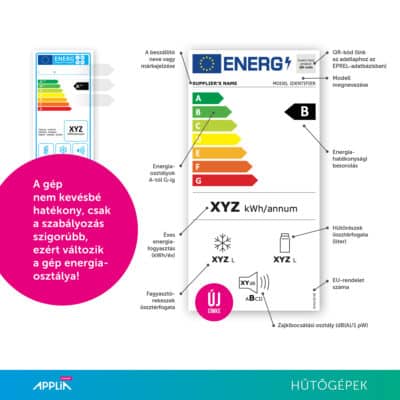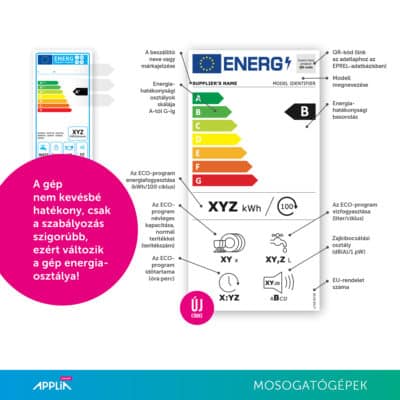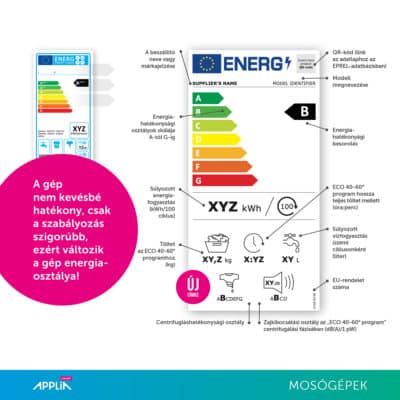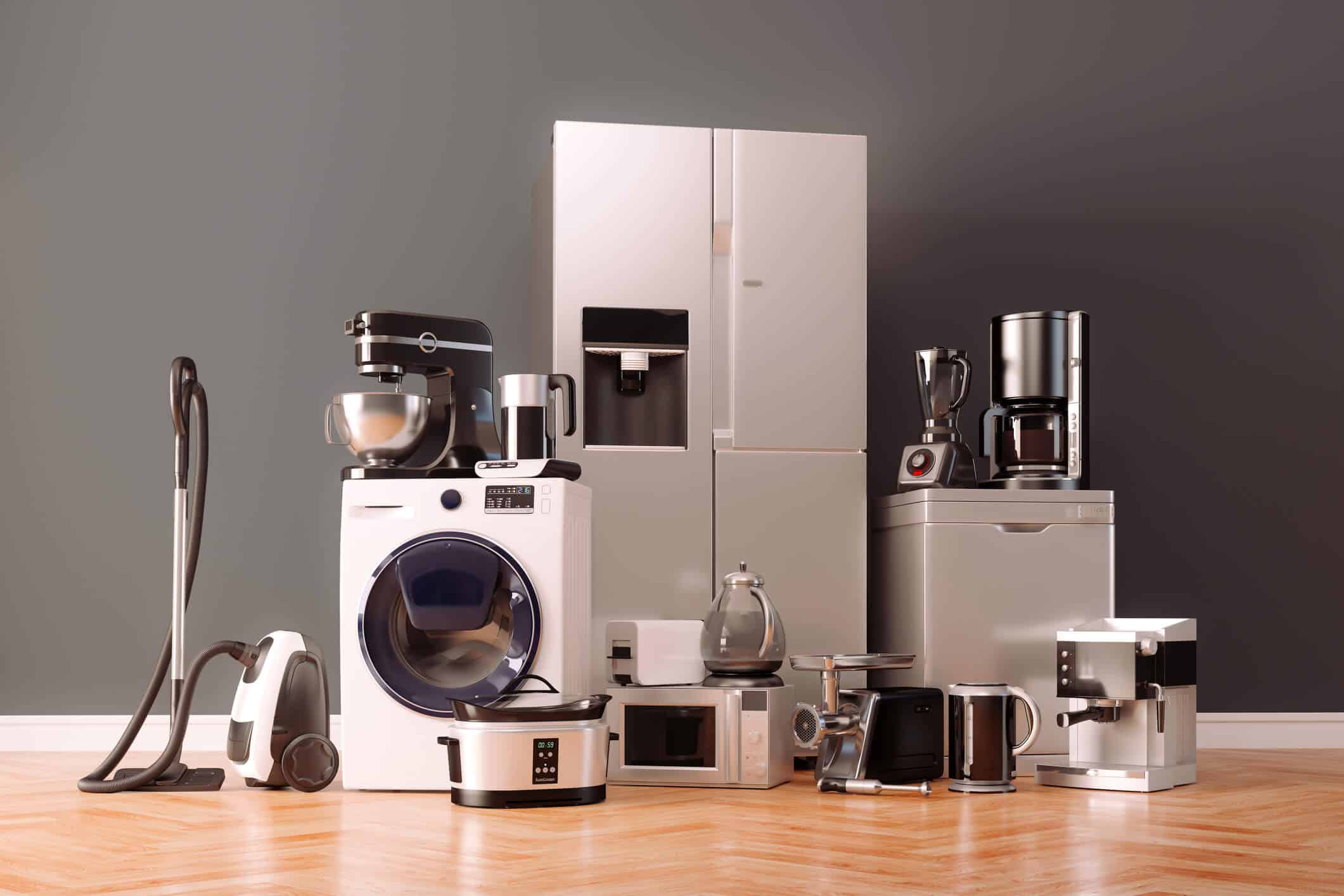New energy label 2021
Let’s take a more detailed look at what we need to know about the new, stricter rules and new labels that entered into force on 1 March 2021..
Is A the best?
The most important change introduced by the new label is that the highest energy class will be Class A, meaning that the + energy classes will be eliminated. The question may arise: will an appliance that was previously an A+++ appliance now be an A class appliance? The answer is not that simple. If we take a look at dishwashers, for example, in the past, a dishwasher could get an A+++ energy rating if its so-called overall energy index (EEI) was less than 50. However, a washing machine that was previously rated A+++ can now be rated D, C or even B, depending on its EEI rating. In fact, the legislation defines the new energy classes for dishwashers as follows:
A – EEI < 32
B – 32 ≤ EEI < 38
C – 38 ≤ EEI < 44
D – 44 ≤ EEI < 50
E – 50 ≤ EEI < 56 (this is the current A++ class)
F – 56 ≤ EEI < 62 (ez nagyjából a jelenlegi A+ osztály, amely a jelenleg forgalomba hozható legkevésbé hatékony osztályú gépeket adja)
G – 62 < EEI
(this is more or less the current A+ class, which is the least efficient class of machines currently on the market)
Thus, former A+++ class dishwashers are now in class B, C or D, depending on their actual consumption, A++ machines are now in class E and A+ appliances in class F.
Such a comparison cannot even be made for washing machines, since the EEI calculation differs significantly under the two regulations (by the way, it should be noted that the calculation is not exactly the same for dishwashers neither, but the results are broadly comparable between the categories). The point is the same for all appliances: machines (washing machines, dishwashers, fridges, freezers), which currently fill only three classes, will in future be split into 6 classes.
It is even possible that an appliance that was previously rated A+++ will in future be rated E! But – as indicated above – this is only because of tightening regulations!
So don’t be frightened, the appliances won’t get any worse! Moreover, as we have seen, it is precisely because of the developments and the increase in the efficiency of the appliances that the new regulation is needed, to differentiate more thoroughly, so that we, the consumers, can more easily distinguish between the different appliances available in the shop.
And importantly, the legislator has been far-sighted this time: it does not want to change the rules again in a couple of years. It has therefore decided that the best class for the new label, class A, should be defined in such a way that it remains empty as far as possible when the label is introduced. (For equipment types where rapid progress is expected in the future, even the top two classes can be left empty initially, as provided for in the framework regulation.)
If the efficiency of appliances continues to improve in the future, and more efficient, more economical machines appear on the market than even the very best machines today, there is no need to change the label immediately: the economical appliances of the future will be in the initially empty Class A (or A and B)!
What else has changed in the label?
Some further changes can also be observed in the new labels. Let’s see what these changes are!
QR code
The new labels have a QR code that we can read with our mobile phone. This will take us to the EPREL database. From the beginning of 2020, manufacturers will be required to upload the technical information of all appliances to a database centrally created and managed by the EU: the European Product Database for Energy Labelling (EPREL). The QR code will guide us to the device’s data sheet, which provides useful information in addition to the information on the energy label.
Noise level classes
Before, the noise level in dB was indicated on the device, but the new label now includes noise level classes. Like the energy class, the noise classes are indicated on a scale from A to G, making it easier to compare appliances.
Energy consumption data
While refrigerators will continue to display the annual consumption figure, washing machines, washer-dryers and dishwashers will display the figure for 100 cycles on the new labels. As far as TVs, displays and light bulbs are concerned, we are given information on the consumption per 1000 hours of use. This important data (energy consumption) will be placed in the middle of all labels in the future.
Other device specific changes
For washing machines, washer-dryers and dishwashers, the eco-program data are shown on the label. Newly, the label also includes information on how long the eco program will run on the machine. For washer-dryers, the left side shows information on the complete washing and drying program, while the right side shows only data for the washing program.
New labelling for refrigerators and freezers

New labelling for wine coolers

New label for dishwashers

New labelling for washing machines

What will happen to the other appliances?
The energy labels of the other appliances will also be renewed, but only at a later date. Check the APPLiA Hungary website and Facebook page for all the latest news!
Click on the image below to watch the related short films of the APPLiA-school:
Relevant legislation:
EU Regulation 2017/1369 (framework for energy labelling): https://eur-lex.europa.eu/legal-content/HU/TXT/PDF/?uri=CELEX:32017R1369&from=hu
EU Regulation 2019/2016 (Regulation on refrigerators and freezers): https://eur-lex.europa.eu/legal-content/HU/TXT/PDF/?uri=CELEX:32019R2016&from=EN
EU Regulation 2019/2014 (Regulation on washing machines and washer-dryers): https://eur-lex.europa.eu/legal-content/HU/TXT/PDF/?uri=CELEX:32019R2014&from=EN
EU Regulation 2019/2017 (Regulation on dishwashers): https://eur-lex.europa.eu/legal-content/HU/TXT/PDF/?uri=CELEX:32019R2017&from=EN
EU Regulation 2019/2013 (Regulation on televisions): https://eur-lex.europa.eu/legal-content/HU/TXT/PDF/?uri=CELEX:32019R2013&from=EN






